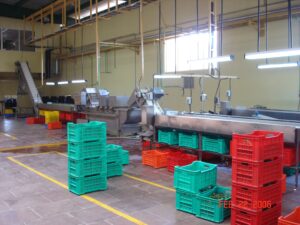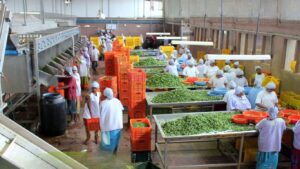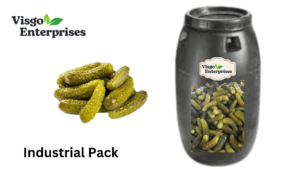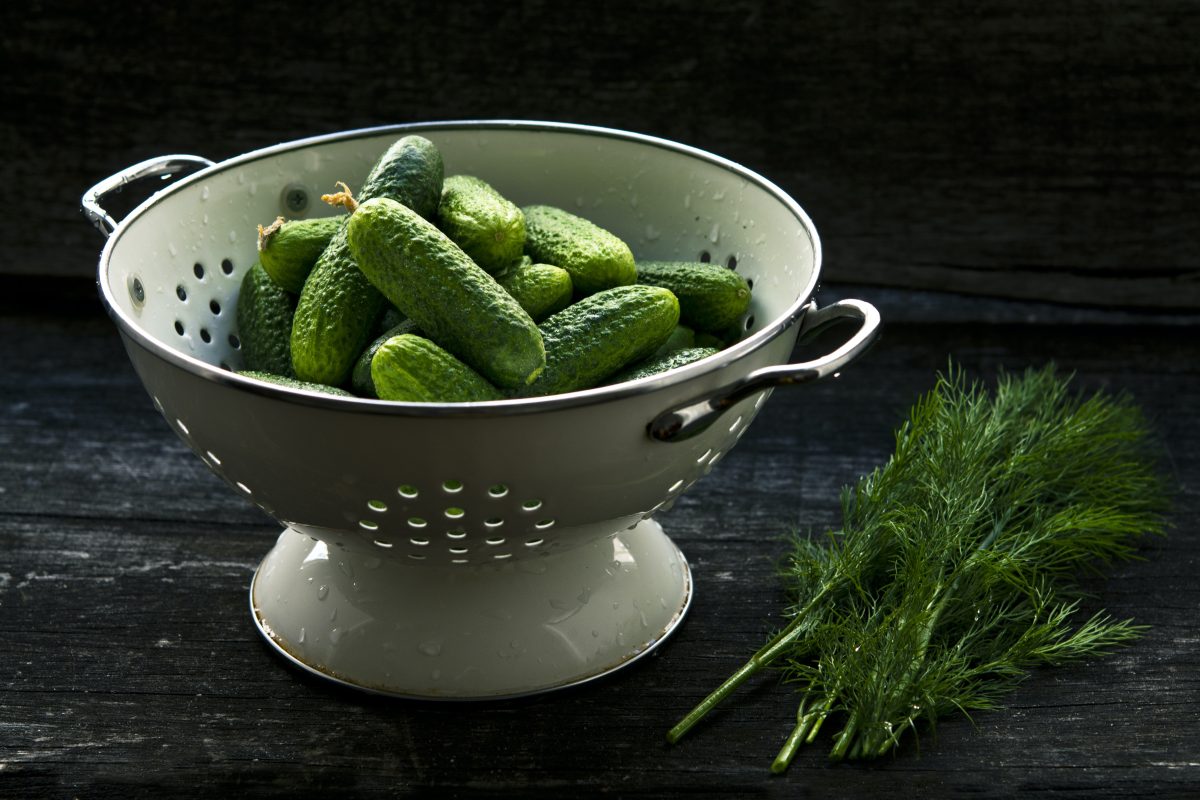Gherkin or Baby cucumber farming in India (Contract Farming)
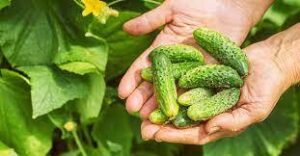
Table of content
-
Introduction to Gherkin Farming in India
-
Benefits of Contract Farming for Cucumber Cultivation
-
Essential Requirements for Successful Gherkin Farming
-
Finding Reliable Buyers and Establishing Contracts
-
Cultivating and Managing Gherkin crops
-
Harvesting, Processing, and Packaging Gherkins
-
Marketing and Selling Gherkins for Profit
-
Challenges and Risks in Gherkin Farming
-
Conclusion: A Lucrative Opportunity in Indian Agriculture
1. Introduction to Gherkin Farming in India
Gherkin farming – the cultivation of cucumbers specifically for pickle production – is a lucrative business in India. With the demand for pickles and gherkins increasing both domestically and internationally, there is a great opportunity for farmers to engage in profitable cucumber cultivation through contract farming.
With over two decades of experience, Visgo Enterprises has become a leading exporter of pickle gherkin in India, providing a comprehensive guide for farmers interested in entering this market. This blog article will explore the ins and outs of gherkin farming in India, covering everything from the cultivation process to market trends and contract farming agreements.
Whether you are a seasoned farmer looking to diversify your crops or a newcomer to the agricultural industry, this guide will provide you with all the information you need to succeed in gherkin farming and maximize your profits. Join us as we dive into the world of contract farming for profitable cucumber cultivation in India!
2. Benefits of Contract Farming for Cucumber Cultivation

One of the key reasons why contract farming is beneficial for cucumber cultivation lies in the assurance it provides to farmers in terms of market access and stable income. By entering into a contract with a reliable buyer or export company like Visgo Enterprises, farmers can avoid the uncertainties of the market and guarantee a ready market for their produce.
Contract farming also offers various other benefits such as access to improved farming practices, technical assistance, and quality inputs. With the guidance and support from these companies, farmers can enhance their knowledge and skills in gherkin farming, leading to increased yields and improved quality of cucumbers.
Additionally, contract farming agreements often involve guaranteed pricing which offers farmers financial security and a fair return on their investment. This stability allows farmers to plan their production and manage their finances effectively, ultimately leading to higher profitability.
In the next section, we will delve deeper into the various aspects of contract farming for cucumber cultivation and explore the steps involved in entering into a contract with a reliable buyer. Stay tuned to learn how contract farming can transform your cucumber cultivation business into a highly profitable venture.
3. Essential Requirements for Successful Gherkin Farming


To ensure successful gherkin farming, there are certain essential requirements that farmers need to fulfill. These requirements include:
1. Adequate Land: Gherkins require well-drained soil with good fertility. The land should have a pH level of around 6 to 6.5. It should also have access to proper irrigation facilities to ensure consistent moisture levels.
2. Quality Seeds: It is important to use high-quality gherkin seeds for better germination and yield. Farmers should source seeds from reliable suppliers who specialize in gherkin farming.
3. Crop Rotation: Gherkin farming should be practiced in a crop rotation system to prevent the buildup of pests and diseases. Avoid planting gherkins in the same field consecutively to maintain soil health.
4. Pest and Disease Management: Regular scouting and timely management of pests and diseases are crucial for a successful gherkin harvest. Farmers should adopt integrated pest management practices and seek guidance from agronomists or agricultural extension services.
5. Post-Harvest Handling: Proper handling and storage of gherkins are crucial to maintain their quality and prolong their shelf life. Farmers should have access to appropriate post-harvest infrastructure and facilities.
By meeting these requirements, gherkin farmers can ensure a higher probability of success in their cultivation endeavors. In the next section, we will discuss the specific steps involved in entering into a contract farming agreement for gherkin cultivation. Stay tuned to learn more about the contractual aspects of profitable cucumber farming.
4. Finding Reliable Buyers and Establishing Contracts

Once the essential requirements for gherkin farming are met, the next step is to find reliable buyers and establish contracts. This is a crucial aspect of profitable cucumber cultivation as it ensures a guaranteed market for the produce.
To find potential buyers, farmers can explore various channels such as local vegetable markets, food processing companies, and export-oriented businesses. Connecting with agricultural cooperatives and farmer producer organizations can also open up opportunities for contract farming.
When entering into a contract farming agreement, it is important to clearly define the terms and conditions, including the quantity, quality, and pricing of the gherkins. Both parties should agree on a fair price that takes into account market trends and production costs.
Moreover, it is advisable to seek legal advice and draft a well-written contract that safeguards the interests of both the farmer and the buyer. The contract should outline the responsibilities of each party and include provisions for dispute resolution.
By establishing contracts with reliable buyers, gherkin farmers can enjoy a steady income and minimize the risks associated with market fluctuations. In the next section, we will delve deeper into the financial considerations and profitability of gherkin farming. Stay tuned for valuable insights into maximizing profits in cucumber cultivation.
5. Cultivating and Managing Gherkin crops
In order to successfully cultivate and manage gherkin crops, farmers must pay attention to several key factors. Firstly, it is crucial to choose the right variety of cucumber that is suitable for gherkin farming. Varieties that have a high yield, disease resistance and good shelf life are preferred. Farmers can consult agricultural experts or local agricultural extension services for guidance on selecting the right variety.
Once the variety is chosen, farmers need to focus on providing the crops with the optimal conditions for growth. Gherkins thrive in well-drained soil with a pH level between 6.0 and 7.0. Adequate water supply, regular irrigation, and proper drainage are essential for healthy crop development.
Proper spacing between plants is also crucial. It is recommended to have a spacing of 1 to 1.5 feet between plants in a row, with 2.5 to 3 feet between each row. This allows for adequate air circulation and sunlight penetration, reducing the risk of diseases and improving yield.
Furthermore, gherkins require proper nutrition to grow and produce high-quality fruits. Farmers can ensure optimal nutrient levels by conducting soil tests and using suitable fertilizers. Nitrogen, phosphorus, and potassium are the primary macronutrients required by gherkin plants, and farmers need to ensure proper balance and recommendations listed based on soil test results.
Lastly, pests and diseases can significantly impact gherkin crops. Farmers must implement effective pest and disease management strategies to protect their plants. This may include using organic pesticides, crop rotation, maintaining proper hygiene, and timely scouting for pests or diseases.
By implementing these cultivation and management practices, gherkin farmers can enhance their crop yield, improve fruit quality, and maximize profitability. In the next section, we will delve into the marketing and selling aspect of gherkin farming, providing valuable insights on reaching target markets and increasing profits. Stay tuned for more information on this exciting aspect of cucumber cultivation.
6. Harvesting, Processing, and Packaging Gherkins

Once the gherkin plants have matured and the fruits have reached the desired size, it is time for farmers to start the harvesting process. Gherkins are typically harvested manually, carefully plucking each fruit from the plant to avoid any damage. It is important to harvest gherkins at the right time to ensure optimal flavor and texture.
After harvesting, the gherkins need to be processed to preserve their freshness and extend their shelf life. This involves sorting the fruits based on their size and quality, washing them thoroughly, and removing any blemishes or bruises. Farmers can also consider grading the gherkins based on their appearance and uniformity.
Once the gherkins have been sorted and cleaned, they need to be properly packaged for sale. Packaging plays a crucial role in preserving the quality and appearance of the gherkins during transportation and storage. It is recommended to use food-grade packaging materials that are durable and provide adequate protection.
Farmers can also consider adding value to their gherkins by pickling or fermenting them. This not only increases the shelf life of the gherkins but also opens up opportunities for selling different products like pickles or relishes.
In the next section, we will explore the various marketing and selling strategies that gherkin farmers can employ to maximize their profits. Stay tuned for valuable insights on reaching target markets and establishing successful sales channels for your gherkin produce.
7. Marketing and Selling Gherkins for Profit
Marketing and selling gherkins for profit is a vital aspect of successful cucumber cultivation. Once your gherkins have been harvested, processed, and properly packaged, it is time to focus on reaching your target markets and establishing successful sales channels.
One effective strategy is to identify potential buyers and build strong relationships with them. This can be done by attending trade fairs, agricultural exhibitions, and networking events where you can showcase your gherkin produce. Additionally, consider establishing connections with local restaurants, hotels, and grocery stores that may be interested in purchasing your fresh or pickled gherkins.
Another option is to explore online platforms and e-commerce websites to reach a wider customer base. Creating a professional website and utilizing social media platforms can help promote your gherkin products and attract potential buyers. Consider offering special promotions or discounts to encourage customers to try your high-quality gherkins.
Furthermore, consider exploring export opportunities to expand your market reach. Research international markets that have a demand for gherkins, and ensure you comply with all necessary regulations and standards for exporting.
Remember, effective marketing and selling strategies play a crucial role in maximizing your profits from gherkin farming. In the next section, we will delve deeper into the logistics and transportation considerations essential for ensuring the timely delivery and freshness of your gherkin produce. Stay tuned for valuable insights on optimizing your supply chain and distribution network.
8. Challenges and Risks in Gherkin Farming
While gherkin farming can be a profitable venture, it is important to be aware of the challenges and risks that come with it. Understanding these factors can help you develop effective strategies to mitigate potential setbacks and ensure the success of your cucumber cultivation.
One of the main challenges in gherkin farming is the susceptibility of the crop to pests and diseases. Cucumber beetles, aphids, powdery mildew, and fungal infections are common issues that can damage your crops and lead to reduced yields. Investing in proper pest management techniques and disease prevention measures is crucial to protect your gherkin plants and maximize your harvest.
Additionally, weather conditions can also pose a risk to gherkin farming. Excessive rainfall or drought can impact the growth and overall health of your crops. It is important to monitor weather forecasts and implement appropriate irrigation strategies to ensure your gherkins receive the necessary water without being overwatered.
Another challenge is the fluctuating market prices and demand for gherkins. Factors such as competition, consumer preferences, and economic conditions can affect the profitability of your gherkin farming business. It is advisable to stay updated with market trends, maintain good relationships with buyers, and explore diversification options to mitigate the impact of market fluctuations.
Lastly, managing the logistics and transportation of your gherkin produce can be a significant challenge. Ensuring timely delivery and maintaining the freshness of your gherkins require careful planning and coordination. Working with reliable transport and logistics partners, as well as implementing proper packaging and storage practices, can help minimize the risks associated with transportation.
By being aware of these challenges and risks, you can proactively address them and increase the chances of success in your gherkin farming venture. In the next section, we will discuss the importance of proper crop management techniques for optimal gherkin yield and quality. Stay tuned for valuable insights on nurturing your gherkin plants and maximizing your harvest.
9. Conclusion: A Lucrative Opportunity in Indian Agriculture
Previous blog section: In the next section, we will discuss the importance of proper crop management techniques for optimal gherkin yield and quality. Stay tuned for valuable insights on nurturing your gherkin plants and maximizing your harvest.
Next section:
In conclusion, gherkin farming holds immense potential for profitability in the Indian agriculture industry. Despite the challenges and risks associated with this venture, a thorough understanding of the market dynamics, effective pest and disease management, proper crop management techniques, and efficient logistics can lead to a successful and profitable gherkin cultivation business.
By staying updated with market trends and consumer preferences, you can make informed decisions regarding the timing of planting, harvesting, and selling your gherkins. Implementing reliable pest control and disease prevention measures will protect your crops and ensure higher yields. Adopting proper crop management practices, such as regular pruning, fertilization, and irrigation, will promote healthy plant growth and enhance the quality of your gherkins.
Furthermore, forging strong relationships with buyers and exploring diversification options can help mitigate the impact of market fluctuations and ensure a steady demand for your produce. Lastly, by partnering with reliable transportation and logistics services, you can guarantee timely delivery and maintain the freshness of your gherkins, thereby maximizing their market value.
Overall, gherkin farming in India offers a lucrative opportunity for farmers to generate profits and contribute to the growth of the agricultural sector. With proper planning, diligent execution, and continuous learning, success in the gherkin farming business is within reach. Embrace this opportunity and embark on a journey towards a sustainable and profitable cucumber cultivation enterprise.
 Are you a fan of tangy, crunchy pickles? If so, then gherkin pickles should be at the top of your must-try list. These small, sour pickles bring a punch of flavor to any meal or snack. Whether you’re looking for a crisp bite to enjoy solo or seeking the perfect pickle to complement your sandwiches and salads, gherkins deliver a unique taste experience. Let’s dive into the world of gherkin pickles and explore their different varieties, flavors, and uses!
Are you a fan of tangy, crunchy pickles? If so, then gherkin pickles should be at the top of your must-try list. These small, sour pickles bring a punch of flavor to any meal or snack. Whether you’re looking for a crisp bite to enjoy solo or seeking the perfect pickle to complement your sandwiches and salads, gherkins deliver a unique taste experience. Let’s dive into the world of gherkin pickles and explore their different varieties, flavors, and uses!




